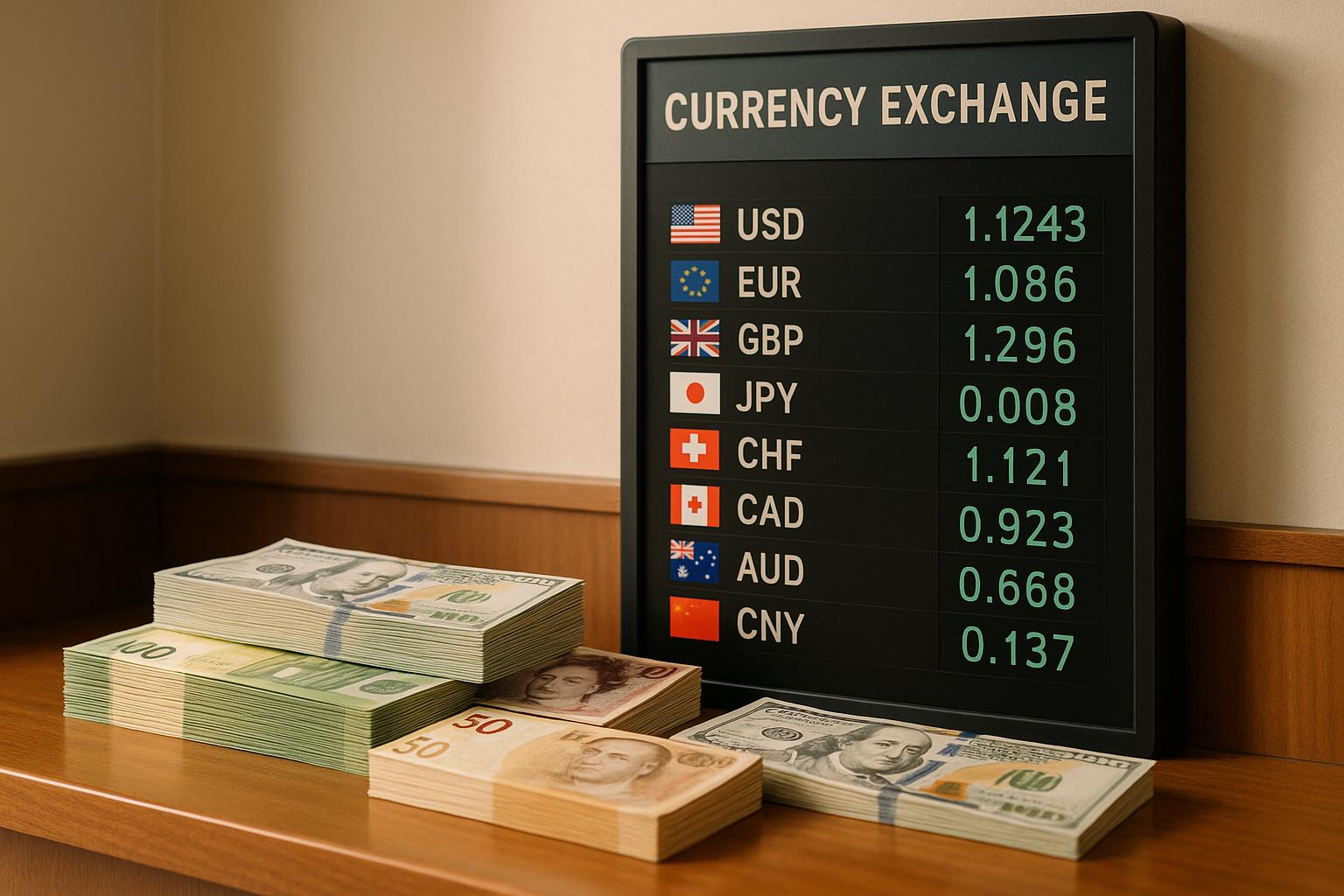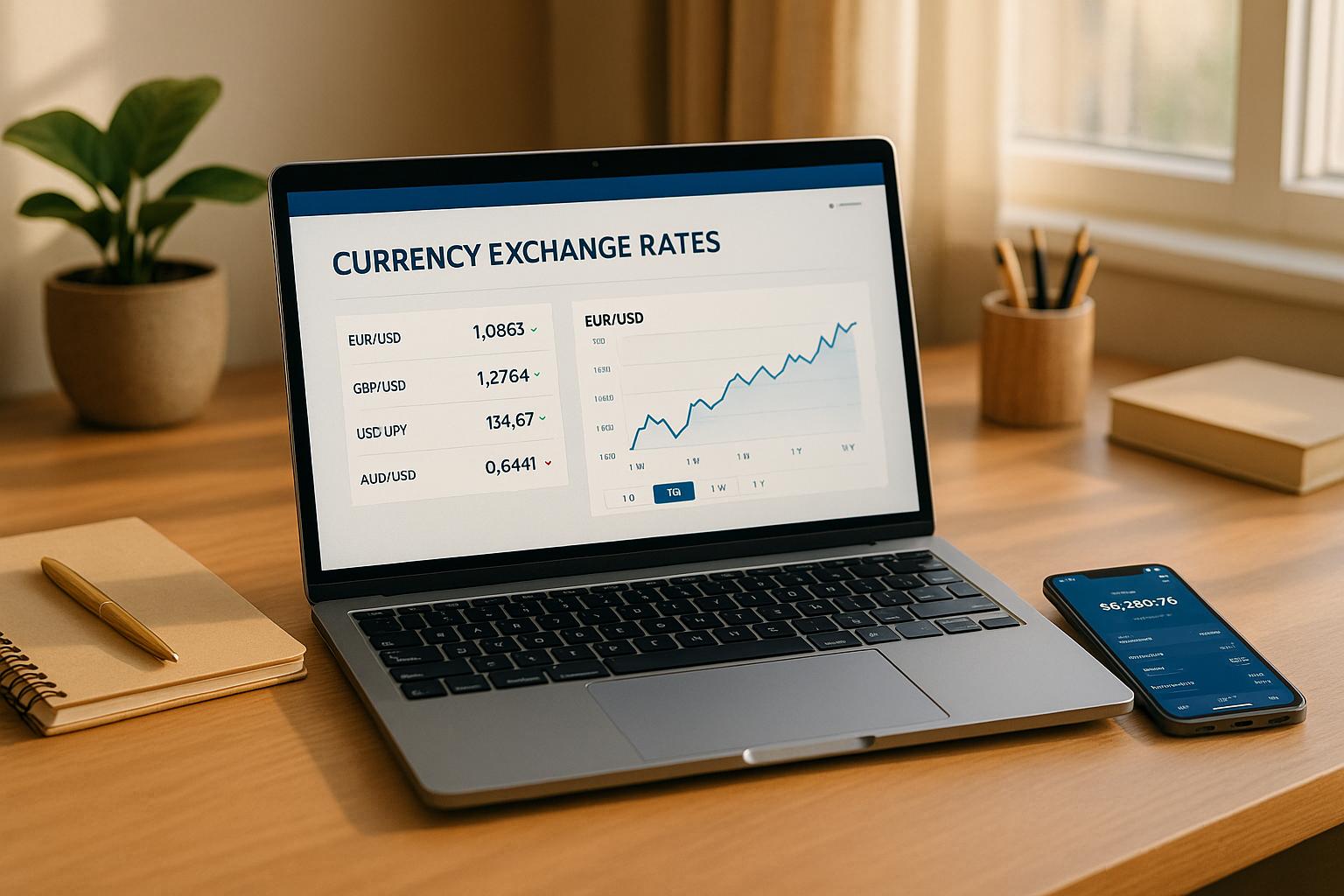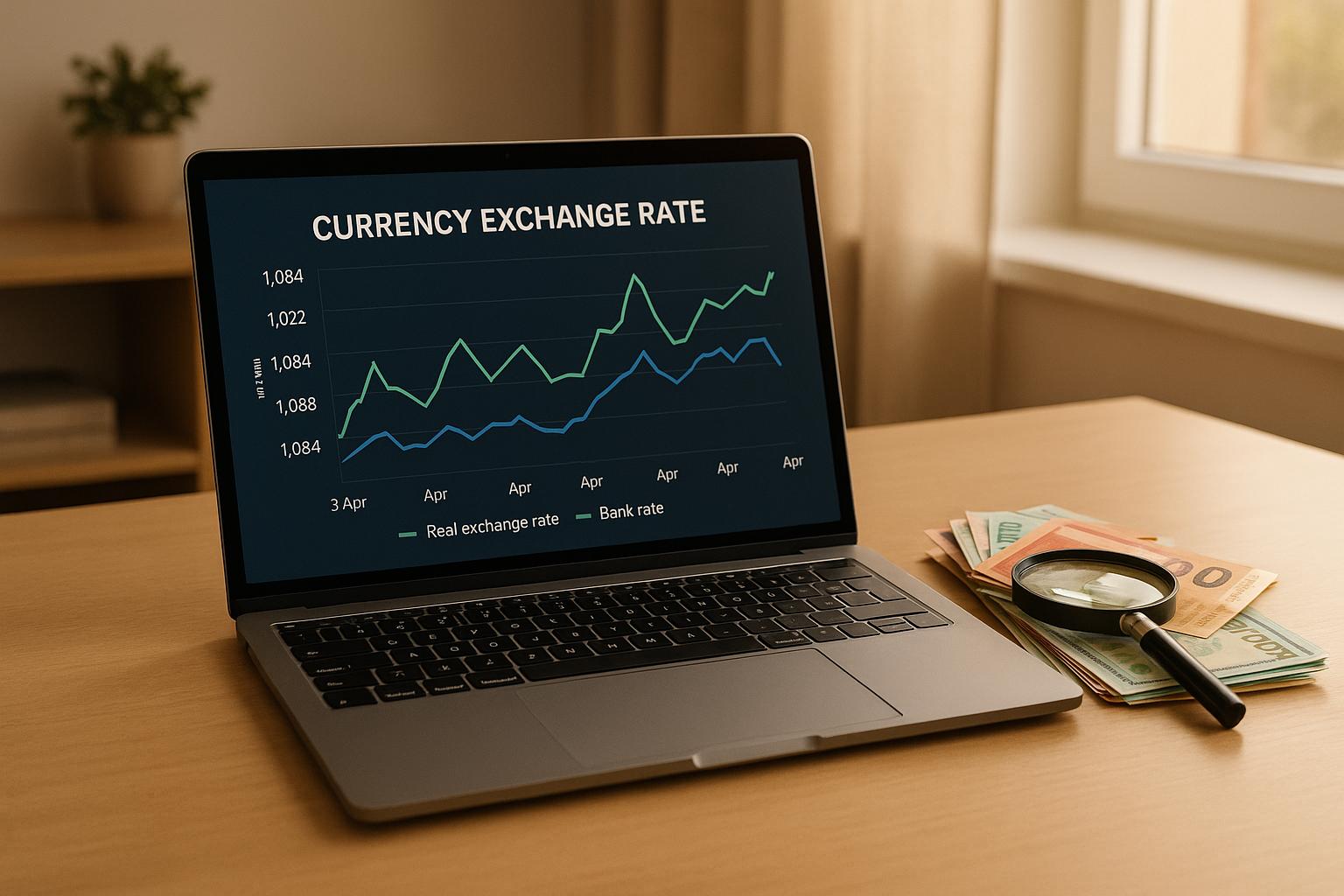Hidden FX fees are quietly draining profits from UK businesses making international payments. Many companies unknowingly lose thousands annually due to unclear charges embedded in exchange rates, transfer fees, and intermediary bank costs. For example, banks often charge between 3% and 5% of transaction values, meaning a £10,000 transfer could cost up to £500 in hidden fees.
Key takeaways:
- Margin spreads: Banks add markups of 1.5%–5% on exchange rates.
- Transfer fees: Outgoing and intermediary bank fees range from £10 to £50 per transfer.
- Non-sterling transaction fees: Typically 2.75%–3% on card payments abroad.
- Lack of transparency: 92% of European banks fail to disclose currency conversion fees.
How to reduce these costs:
- Check statements for hidden fees.
- Compare exchange rates to mid-market rates.
- Negotiate better terms with your provider.
- Use multi-currency accounts to avoid double conversions.
- Consider forward contracts to lock in favourable rates.
Common Types of Hidden FX Fees
Understanding the various hidden fees in foreign exchange (FX) transactions is essential to avoid unnecessary expenses. These charges are often embedded in standard banking practices, making it vital to scrutinise your transactions carefully. Below, we’ll explore some of the most common hidden fees that can impact international business payments.
Margin Spreads
Margin spreads are among the most significant hidden costs in FX transactions. This refers to the difference between the bid (selling) price and the ask (buying) price of a currency pair. Essentially, it’s a built-in cost that affects profitability. Spreads tend to be narrower in highly liquid markets and wider during periods of low liquidity or increased volatility.
There are two main types of spreads businesses encounter:
- Fixed spreads: These remain constant, offering a level of predictability.
- Variable spreads: These fluctuate depending on market conditions.
To minimise these costs, consider exchanging currency during peak liquidity hours in major financial centres and shop around for the best rates from different providers.
Non-Sterling Transaction Fees
If your UK-based business makes payments in a currency other than pound sterling, non-sterling transaction fees may apply. These charges occur when your card issuer converts a foreign currency transaction into sterling, often adding an extra cost. Typically, these fees are around 3% of the transaction value, with some UK banks charging between 2.75% and 2.99%.
To identify these fees, review your bank or credit card statements and fee disclosures. If the information isn’t clear, contact your provider. When making payments abroad, always opt to pay in the local currency to avoid dynamic currency conversion fees.
| Bank | Purchases | Withdrawals |
|---|---|---|
| HSBC (except Premier and Advance debit cards) | 2.75% | 2.75% + 2% cash fee (min £1.75, max £5) |
| Lloyds (all debit cards) | 2.99% + £0.50 purchase fee | 2.99% + £1.50 cash fee |
| Halifax (all debit cards) | 2.99% + £0.50 purchase fee | 2.99% + £1.50 cash fee |
| Barclays (all debit cards) | 2.75% | 2.75% |
| Santander (except Zero debit card) | 2.75% | 2.75% |
Transfer Fees and Correspondent Bank Fees
Transfer fees are the charges for initiating an international transfer, while correspondent bank fees are additional costs imposed by intermediary banks that facilitate the payment process. Since sending and receiving banks often don’t have direct connections, intermediary banks step in to bridge the gap.
Here’s a breakdown of typical costs:
- Outgoing wire transfer fees: Range from US$35 to US$50, charged by the sender’s bank.
- Intermediary bank fees: US$15 to US$30 per bank involved in the transaction.
- Incoming wire fees: US$10 to US$20, deducted by the recipient’s bank.
- Currency conversion fees: Typically 2% to 5%, added as a markup on the exchange rate.
- Amendment or recall fees: US$25 to US$75 for changes or cancellations.
| Fee Type | Estimated Cost | Description |
|---|---|---|
| Outgoing wire transfer fee | US$35 – US$50 | Charged by the sender's bank to initiate the transfer |
| Intermediary bank fees | US$15 – US$30 per bank | Additional charges from banks processing the transfer along the way |
| Incoming wire fees | US$10 – US$20 | Deducted from the amount received by the recipient's bank |
| Currency conversion fee | 2% – 5% | Markup added to the exchange rate by banks or providers |
| Amendment or recall fee | US$25 – US$75 | Charged when a sender needs to change or cancel a transfer |
To lower these costs, try negotiating fee waivers with your bank, especially if you handle high transaction volumes. Using multi-currency accounts can also help you avoid double conversion fees. Additionally, batching payments can reduce per-transfer charges, and requesting an MT103 document can provide a detailed breakdown of the fees.
Other Hidden Costs
Besides the primary charges, there are other fees that can quietly erode your funds:
- Settlement charges: Applied when payments go through specific networks or clearing systems.
- Network and issuer fees: Imposed for using certain payment rails or card-based transactions.
- Exchange rate delays: Fluctuations during processing, especially over weekends or holidays, can lead to additional costs.
- Amendment and recall fees: These range from US$25 to US$75 per modification.
- Account maintenance fees: Multi-currency accounts may come with upkeep costs, minimum balance requirements, or inactivity charges.
Understanding and identifying these varied charges is essential to keeping your FX transaction costs under control.
Checklist: How to Find and Reduce Hidden FX Fees
Hidden FX fees can quietly drain 1–2% of your revenue, and with over half of businesses grappling with high fees and poor exchange rates, tackling these costs is a smart move for your bottom line. Here’s a step-by-step guide to help you uncover and reduce these fees effectively.
Check Statements and Fee Disclosures
Start by examining your bank statements for any unexpected charges. Many banks include their FX margins directly within the exchange rate, making it harder to spot.
Key charges to look out for:
- Non-sterling transaction fees
- Wire transfer fees
- Correspondent bank charges
- Currency conversion markups
Using tools like a bank statement analyser can help flag these hidden fees automatically. For instance, one business discovered excessive conversion margins through such a tool and switched to a specialised international bank, saving over £2,000 annually.
Compare Exchange Rates to Market Rates
Verify your bank’s exchange rate by comparing it to the mid-market rate. You can check live rates on platforms like Google or XE before making payments. Then, compare the rate on your Foreign Inward Remittance Advice or bank statement with the mid-market rate from the same day to determine the markup.
How to calculate the markup:
- Note the mid-market exchange rate at the transaction time.
- Compare it to the rate your bank applied.
- Calculate the percentage difference to identify the markup.
- Use tools like mycurrencycost.com for an easy comparison with real market values.
Banks and brokers often make FX transactions unnecessarily complex to obscure their fees. By keeping an eye on mid-market rates regularly, you can identify excessive charges and take action.
Negotiate Fees and Rates
Don’t hesitate to challenge the rates and fees you’re offered. According to a LendingTree survey, 64% of people who requested a reduction or waiver of FX fees were successful. If you deal with international payments often, negotiating better terms can lead to significant savings.
Tips for negotiation:
- Highlight your transaction volume to strengthen your case.
- Show evidence of better rates from competitors.
- Bundle services to create a more appealing deal for your bank.
- Ask for fee waivers, especially if you’re a high-volume client.
For example, a company with £4.8 million in revenue was spending £32,000–£40,000 on FX transfers annually. By addressing these fees, they redirected funds to marketing and hiring instead.
Use Multi-Currency Accounts
Multi-currency accounts can help you minimise conversion costs for frequent international transactions. These accounts let you hold and receive payments in different currencies, giving you the flexibility to exchange funds when rates are more favourable.
Advantages of multi-currency accounts:
- Avoid double conversion fees when sending and receiving in the same currency.
- Time conversions to benefit from better exchange rates.
- Reduce the number of currency exchanges.
- Keep balances in currencies you use often.
Platforms offering virtual accounts in USD, EUR, and GBP can help you avoid SWIFT fees. For instance, a restaurant owner saved £240 annually by consolidating accounts, setting up automated transfers, and maintaining minimum balances effectively.
Consider Forward Contracts
Forward contracts let you lock in exchange rates for future transactions, shielding your business from currency fluctuations. This is especially useful for businesses with regular international payments or those operating in volatile markets.
When forward contracts are a good option:
- You have consistent international payment schedules.
- Currency volatility is a concern for your profit margins.
- Accurate budgeting for future expenses is a priority.
- You’re making large transactions where rate changes could have a big impact.
Some platforms even allow you to set alerts for favourable FX rates, helping you time your transactions better. Advanced plans may also offer access to FX experts for tailored advice based on market trends.
With 41% of businesses struggling to manage currency fluctuations, forward contracts can be a vital tool to stabilise costs and plan ahead with confidence.
sbb-itb-1645b7c
Tools and Methods for FX Fee Comparison
Finding competitive FX rates can be tricky, especially with hidden markups often buried in exchange rates. Transparent comparison tools are a game-changer, helping businesses identify these hidden costs and lock in better rates. Here’s a closer look at some of the tools and methods you can use to make smarter FX decisions.
FX Rate Comparison Tools
Traditional banks are notorious for their lack of transparency when it comes to FX rates. That’s where modern comparison tools step in. Platforms like mycurrencycost.com allow businesses to spot exchange rate markups by comparing provider rates against the mid-market rate. This gives a clear view of how much extra you might be paying.
One user shared their experience:
"I reviewed the books and realised quite how much I was losing out on when taking payments in foreign currencies. This was both in terms of payment fees and FX - it didn't feel right and I thought that in this day and age there must be a better way."
These tools go beyond basic guidance by offering real-time, detailed comparisons, making it easier to see where you can save.
Historical Rate Analysis
Looking at historical FX rates can give you a better sense of which providers consistently offer fair rates, rather than relying on the occasional good deal. This type of analysis also helps you spot trends and time your transactions strategically. Many platforms now provide access to historical currency data, rate alerts, and APIs to aid in this process.
Key benefits of historical rate analysis include:
- Recognising patterns: Spot trends to anticipate rate changes and make informed decisions.
- Comparing providers: See how different providers' rates have performed over time.
- Assessing risk: Understand past volatility to prepare for future fluctuations.
- Testing strategies: Use historical data to back-test your FX strategies, giving you a clearer edge.
By analysing recent trends and economic influences, you can better time your FX transactions and potentially save more.
Forward Contract Rate Checks
Forward contracts can be a useful tool for locking in FX rates, but it’s crucial to evaluate them carefully. To make effective comparisons:
- Look at forward rates from multiple providers.
- Review interest rate differentials and any associated transaction costs.
- Use a forward efficiency tool to measure how favourable the contract is for your needs.
Interest carry, for instance, can indicate whether a forward contract will result in a cost or a gain compared to the current spot rate. This insight is especially helpful for determining whether a forward contract is a cost-effective option for your business.
To stay ahead, consider setting up rate alerts on reliable platforms. These alerts notify you when your target exchange rates are available, allowing you to act quickly and secure favourable forward contracts. For businesses handling regular international payments, this proactive approach can lead to noticeable savings over time.
Conclusion: Reducing FX Transaction Costs
Key Points
Let’s sum up the most effective ways to cut down on foreign exchange (FX) costs.
Hidden FX fees can quietly drain your profits, but they’re not inevitable. On average, UK SMEs lose around £70,000 annually due to exchange rate losses. Cross-border payment inefficiencies can consume as much as 5–7% of a business’s revenue.
By embracing modern tools and strategies, businesses can significantly minimise these expenses. While traditional banks often add markups of about 2–3% above the mid-market rate, specialised platforms offer rates closer to 0.5–2%. Fintech payment platforms, in particular, charge only a fraction - roughly one-fifth - of what traditional banks demand.
Transparent FX tools are game-changers. Platforms like mycurrencycost.com help you compare provider rates against the mid-market rate, turning hidden fees into clear, manageable numbers. These strategies address the core issues behind high FX costs: lack of transparency, missed negotiation opportunities, and outdated payment methods.
Next Steps for Businesses
Now that you’re aware of the hidden costs, here are some practical steps to take:
- Track your current costs: Start by analysing your cross-border payment volumes and fees this month. Understanding your exchange rate spreads and total fees will provide a baseline for measuring improvements.
- Compare rates: Use FX comparison tools to check competitor rates. Input your typical transaction details to see if your current provider is offering a fair deal.
- Negotiate smarter: Armed with a strong business case, approach your FX provider for better rates. Regular international payment volumes often give businesses leverage during negotiations.
- Switch to fintech platforms: Modern payment platforms often provide better rates, transparent pricing, and faster settlement times. Switching to these platforms could save your business 40–90% on international transfer costs compared to traditional methods.
- Set rate alerts: Keep an eye on favourable exchange rates by setting up alerts. This allows you to act quickly when rates are advantageous, rather than settling for whatever’s available at the time.
Focus on areas with the highest payment volumes or frequent transactions first. Even small improvements in these areas can add up to substantial annual savings for your business. By taking control of your FX costs, you can turn what was once a profit drain into a manageable and optimised part of your financial operations.
FAQs
How can I tell if my business is paying hidden fees on foreign exchange transactions?
Hidden foreign exchange (FX) fees can be sneaky, but there are a few ways to uncover them. Start by looking closely at the exchange rate margins offered by your provider. These often include markups that aren’t openly disclosed. To spot any hidden charges, compare the rates you’re offered with the mid-market rates available online.
Next, take a careful look at all transaction-related documents. Watch out for extra costs like transfer fees, intermediary bank charges, or receiving bank fees. These may not be obvious at first glance but can quietly stack up over time, eating into your funds.
To keep these hidden costs in check, make it a habit to compare FX providers regularly and get a clear understanding of how their pricing works. Staying on top of this can help your business cut unnecessary expenses and handle international payments more efficiently.
How can I negotiate better foreign exchange (FX) rates for my business payments?
How to Negotiate Better FX Rates for Business Payments
Getting better FX rates for your business payments starts with doing your homework. Keep an eye on market trends and stay informed about current exchange rates and margins. This knowledge puts you in a stronger position when it’s time to negotiate with your bank or FX provider.
Another smart move is to ask your suppliers to price their goods in GBP (£). This helps you avoid the uncertainty of exchange rate fluctuations and makes your costs more transparent. If you handle large or frequent transactions, it’s worth investing in a solid relationship with your FX provider. Over time, this can lead to personalised rates and better terms. Don’t shy away from requesting a rate review, especially if your transaction volumes grow.
Lastly, don’t limit yourself to just one provider. Compare options and be ready to switch if needed. Providers often value your business enough to negotiate more competitive rates to keep you on board.
How can multi-currency accounts help businesses save on foreign exchange costs?
Multi-currency accounts offer businesses a smart way to cut down on foreign exchange (FX) costs. With these accounts, companies can hold, send, and receive payments in various currencies - all within a single account. This setup eliminates the need for constant currency conversions, which often come with extra fees and less favourable exchange rates.
Another benefit is the flexibility to convert currencies when rates are more advantageous, helping businesses avoid unnecessary costs from FX rate fluctuations. Plus, these accounts typically provide more competitive exchange rates than standard bank accounts, making them a cost-effective choice for managing international transactions.


